Trees are a valuable part of any landscape. They provide shade, wind protection and visual appeal. They also reduce energy costs and serve as recreation for children and habitat for wildlife. Given the value of trees, it is wise to put consideration into their selection, planting and maintenance.
Regardless of its background, any tree suffers a certain amount of “transplanting stress” during the period between planting and establishment. It may take several years after planting for a tree to regenerate a balanced root system. Once established, most trees require very little care. However, site preparation, planting technique and post-planting maintenance will all influence the establishment rate.
When planting a tree, the main objective is to place a plant that is capable of growing roots rapidly into soil providing a good root growth environment. Many factors influence a tree’s ability to grow roots.
Select the best tree
Selection of a high-quality plant that can adapt to conditions at the planting site is a necessary first step. See MU Extension publication G6800, Selecting Landscape Plants: Shade Trees, for transplant recommendations for Missouri. If planting a bare root plant (harvested with no soil around the roots), select plants with large, well-branched root systems that do not appear dry and shriveled.
A tree that is harvested as balled and burlapped (or B&B) should have a firm, symmetrical soil ball that is large enough to conform to accepted nursery standards. For example, a shade tree with a trunk diameter of 2 inches should have a ball that is about 24 inches in diameter. The trunk should not wobble in the ball. In some cases, B&B trees are harvested from the nursery with extra soil on top of the ball. If no main structural roots are found by probing within 2 inches of the top of the ball of the tree, consider another tree.
Container-grown trees should not wobble in the container. Roots should occupy the entire volume of the container but should not circle the pot excessively. Pot-bound plants with a solid mass of circling roots will establish slowly and may continue root circling for many years after planting. This can lead to poor anchorage or even girdling (strangling) of the trunk.
Protect the tree
Once a quality tree is purchased, it is important to keep it in good condition until it is planted. Poor handling between harvest and planting can greatly reduce the vigor and root growth potential of a tree. It is critical that roots never be allowed to dry out. Bare root plants should have their roots soaked for a few (no more than six) hours. If not planted immediately, the tree should be heeled in by covering roots with mulch or soil. Container-grown trees should be watered regularly and kept from freezing. B&B trees should be covered with mulch or soil if not planted soon after purchase. Remember to water B&B trees on a regular basis until planted to keep the soil ball from drying out.
Time to plant
If good horticultural practices are used, trees can be planted any time of the year. Container-grown trees suffer minimal root disturbance during transplanting. If they are carefully watered after planting, trees can be successfully planted even in midsummer.
Bare root trees are generally not available for planting except in their dormant condition, during late winter and early spring. However, research at the University of Missouri has shown that bare root trees can survive summer planting in certain conditions. Bare root trees with up to 2 inches of stem caliper can be planted with excellent survival during the midsummer if preconditioned in a bed of irrigated pea gravel (called the Missouri Gravel Bed) for 10 to 12 weeks. If harvested and stored properly, B&B trees can also be planted at any time of the year.
However, since conditions during midsummer are often stressful to plants, most nursery professionals recommend planting in spring or fall.
Prepare the site
Since a tree may represent a considerable long-term investment, it is wise to prepare the planting site before the tree is purchased. Test the soil for pH and mineral content to determine whether preparation is required to make the site suitable for the species.
Check the water percolation rate by filling an 18-inch-deep hole twice with water. If the second filling takes more than 24 hours to drain, consider improving the drainage by creating raised beds or using drain tiles. If the soil in the proposed planting site is a dense, clay subsoil, it is unrealistic to expect any tree to develop to its full potential without extensive work to help improve the soil.
Finally, light is often overlooked as an important planting factor. Pruning or removal of surrounding plants might be necessary to provide enough light for your new tree.
The "planting hole"
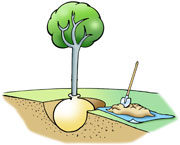 According to recent research on tree root growth after transplanting, the term "planting hole" should be laid to rest. In most soils, 90 percent of the actively absorbing root tips are located within 12 inches of the soil surface. So, it is important to create a soil environment surrounding a new tree where roots can easily grow near the surface. Recent studies have shown that trees root much more slowly in high-density soil than in loose soil.
According to recent research on tree root growth after transplanting, the term "planting hole" should be laid to rest. In most soils, 90 percent of the actively absorbing root tips are located within 12 inches of the soil surface. So, it is important to create a soil environment surrounding a new tree where roots can easily grow near the surface. Recent studies have shown that trees root much more slowly in high-density soil than in loose soil.
Current guidelines suggest planting trees no deeper than they grew in the nursery, and into a soil that has been loosened 8 to 12 inches deep. This area should be equal to two to three times the diameter of the tree's soil ball. Peat moss and compost may help create a favorable root growth environment when mixed with the soil around a new tree. However, these should be used in moderation (less than 20 percent of the soil volume).
When preparing a planting area, it is helpful to place the excavated soil on a tarp next to the hole. This aids in placing the soil back around the root ball once the tree is in place. Dig the hole only as deep as the soil ball and place the ball on undisturbed soil. If no roots larger than 1/2 inch in diameter are found by probing 2 inches deep, on top of the ball, plant the tree 2 to 3 inches higher than the ball depth and remove the excess soil from the top of the ball.
If the soil at the planting site is heavy clay, it is advisable to plant slightly higher than the tree was grown in the nursery. Backfill so that the ball is about one-third exposed and is stable. Remove any twine or rope around the trunk. Many tree planters put water in the hole at this point to settle the soil.
If the ball is being planted high and the top will project out of the ground, it is best to remove the burlap from the top of the ball to prevent wicking of water where burlap is exposed. If the ball comes in a wire basket, most experts recommend removing the top row of squares to minimize chances of eventual root girdling or contact with mowers. After all unwanted materials are removed from the trunk and ball, finish backfilling. If it is not possible to irrigate the new tree with some form of drip irrigation, it may be best to create a basin with backfill soil to hold water applied from a hose or bucket.
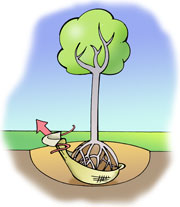 Remove twine from the tree after placing it in the planting hole and do not leave burlap exposed. This may wick water out of the root ball.
Remove twine from the tree after placing it in the planting hole and do not leave burlap exposed. This may wick water out of the root ball.
Protect the bark
Newly planted trees are susceptible to sun scald on the southwest sides of their trunks. Damage usually occurs in late winter as the late afternoon sun warms the bark. Cells in warmed bark are stimulated to grow and are therefore subject to freezing injury when the temperature drops abruptly after sunset. Damage from sun scald provides an opening for stem-boring insects and fungal stem canker diseases.
To prevent sun scald, wrap the trunk of a new tree with light colored material, or paint it white. (Kraft paper wrap is available in many garden stores.) Wrap from the soil line up to the lowest branch. Never use a dark colored trunk wrap. When trees are planted in spring, it may be advisable to wait until fall to wrap, since exposure of the trunk to sunlight during the summer may help thicken the bark and make it more resistant to scald. The wrap should be removed after winter. If the bark still looks thin after the first winter, consider re-wrapping the second fall.
Secure the tree
If the tree is located in an area exposed to strong winds, it is best to stake it. However, secure the tree no higher than one-third of its height from the ground so that the top of the trunk can sway in the wind.
Whether the tree is secured using stakes or guy wires, make certain that no rope or wire directly contacts the trunk. Use rubber hose or specialty fabric straps to attach the tree to the supports. Also, be sure to remove supports one season after planting to prevent trunk girdling.
Pruning
Pruning of new trees should generally be done in moderation. Remove broken or crossing branches and those growing at a narrow angle with the trunk. Thin out some branches if they seem too close, but try to maintain the natural form of the plant. In many cases, the grower will have taken care of these problems before the tree left the nursery. Be careful not to over-fertilize a new tree. If a soil test is done before planting, deficiencies in phosphorus and potassium can be corrected. Add fertilizer to the backfill soil according to soil test recommendations. Excessive nitrogen fertilization at planting can promote rank top growth at the expense of root growth. This makes the tree more susceptible to drought in the heat of summer. A light application of nitrogen fertilizer in midsummer may help to promote root growth over the fall and winter. Keep fertilizers containing broadleaf weed killers as far away from new trees as possible.
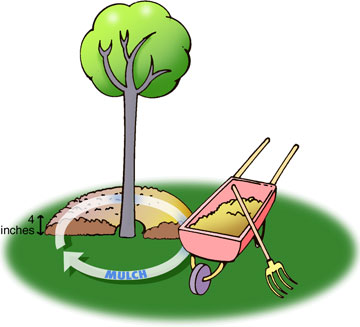 A wide mulch ring (no deeper than 2 to 4 inches) can help protect your tree from turf root growth.
A wide mulch ring (no deeper than 2 to 4 inches) can help protect your tree from turf root growth.
Mulching
Roots of turfgrasses compete strongly with tree roots for water and minerals. Therefore, it is important to mulch a tree as soon as possible after planting to restrict the growth of turf roots into the loosened soil. If trees could talk, they would tell us that there is no such thing as a too-wide mulch ring. Mulch should be no deeper than 2 to 4 inches but should be as wide as is acceptable to the tree owner. Taper the mulch so that it is less than 1 inch deep next the trunk.
Nearly any mulching material will help retain soil moisture and reduce competition with turf roots and weeds. Hardwood bark is relatively inexpensive and is available in bags or in bulk. In general, bark mulch should be supplemented every year to maintain a 2- to 4-inch thickness. Since the pH of bark increases as it decomposes, consider adding a cup or two of elemental sulfur for every cubic foot of mulch. This will keep the underlying soil from becoming too alkaline.
Pine needles, or pine straw, make an excellent mulch and help to keep the pH of the underlying soil in the optimal range for most tree species. While pine straw is the mulch of choice in the southeastern United States, it is often not available in the Midwest. However, research at the University of Missouri indicates that pine straw can be produced in Missouri, so availability may increase. Pine bark, cypress and cedar are all popular, readily available and effective.
Rock mulch is effective in controlling weeds and moderating soil temperature and moisture, but it does not contribute to the organic matter content of the underlying soil as do the organic materials mentioned above.
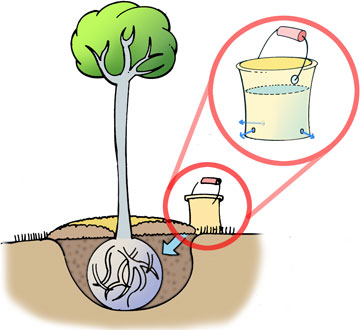 A 5-gallon bucket with drilled holes provides your new tree with a cost-effective drip irrigation method.
A 5-gallon bucket with drilled holes provides your new tree with a cost-effective drip irrigation method.
Remember to water
The single most important survival factor of newly planted trees is soil moisture during the first few months after planting. Remember, until a tree grows roots out into the soil surrounding the original root ball, it is dependent on water contained in the soil ball. The ball of a container-grown tree may become dangerously dry within a day or two after planting in midsummer. Similarly, B&B trees need to be watered frequently with small amounts of water for the first season after planting.
But don't overdo it
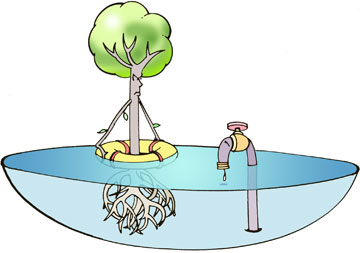 Overwatering new trees during hot conditions can kill them almost as quickly as a lack of water. An effective way to control the moisture level in the original soil ball of a new tree is to use some form of drip irrigation. The simplest method is to use a 5-gallon plastic bucket. (See the figure above.) Drill 1/8-inch-diameter holes in the sides near the bottom, and place the bucket next to the tree. This allows water to slowly trickle into the root ball. Repeating this operation two to three times per week will keep the root ball moist without drowning the tree.
Overwatering new trees during hot conditions can kill them almost as quickly as a lack of water. An effective way to control the moisture level in the original soil ball of a new tree is to use some form of drip irrigation. The simplest method is to use a 5-gallon plastic bucket. (See the figure above.) Drill 1/8-inch-diameter holes in the sides near the bottom, and place the bucket next to the tree. This allows water to slowly trickle into the root ball. Repeating this operation two to three times per week will keep the root ball moist without drowning the tree.
To estimate how much water to irrigate with, calculate the volume of the root zone in cubic feet and add about 2 gallons per cubic foot. For example, a tree bought in a 5-gallon container will have a volume of 1/2 cubic foot. So, it should receive about 1 gallon of water three times per week during drought.
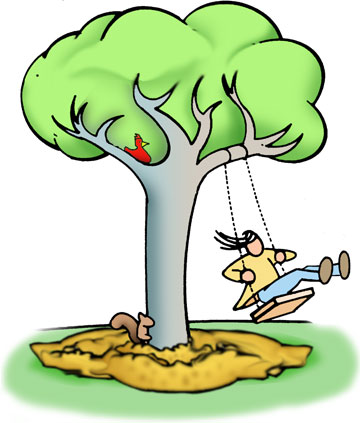 Christopher J. Starbuck
Christopher J. Starbuck